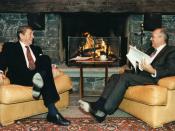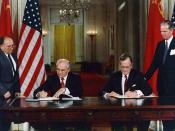During the past half century, the United States has exerted enormous influence on Europe and most especially Western Europe. After the war, the US government, through the Marshall Plan, rebuilt the Western European economies. The term Americanization, which has appeared in European publications, refers in part to this economic and military influence, but it also refers to concerns about cultural loss. American banks and other financial institutions as well as law firms often have European branches. Large American corporations such as the McDonald's fast-food chain have established a presence in European cities from Dublin to Moscow. Furthermore, as Europe moves toward greater economic cooperation, English seems to be emerging as the most common language of business and even of some academic fields. And it is American influence, not British, that lies behind this trend. Between 1913 and 1985, estimates suggest that Europe's population grew by more than 44 percent. Population density rose from 66 people per square kilometer in 1920 to 101 in 1985, and the trend has continued.
The most densely populated regions are the Netherlands, Belgium, England, western Germany, and Italy. Women are also marrying at a younger age than before, particularly in Eastern and Southern Europe. Overall, more people in the last half century have married, and have married at an earlier age, than in all of previous European history.
The decades since WWII have witnessed striking changes in the work patterns and the social expectations of women. The number of married women in the work force has sharply risen. Because of the rather low birthrate in the 1930s, there were not many young single women to be employed in the years just after the war. Married women entered the job market to replace them. In the twentieth century, children have no longer been expected to make...



New Europe and the 21st century
You seem to have a gift for taking dubious notes, ccmustangs2001. These notes are quite thorough, very detailed, flow smoothly and are very informative. This can definintely be used as a research tool, this and any of ccmustangs2001's other notes.
Excellent job, ccmustangs2001.
3 out of 3 people found this comment useful.